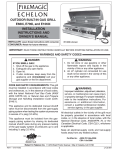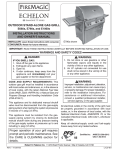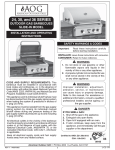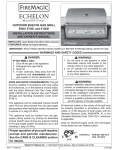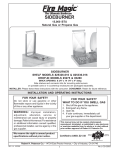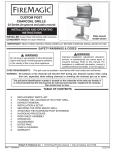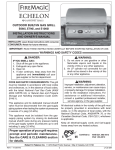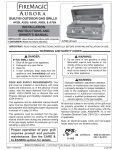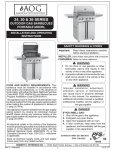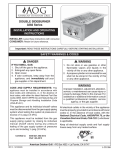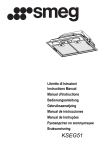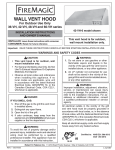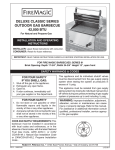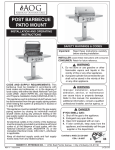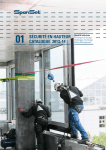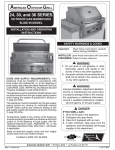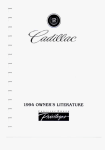Download Fire Magic ECHELON E660 User's Manual
Transcript
ECHELON STAND-ALONE OUTDOOR GAS GRILLS E660s, E790s, and E1060s INSTALLATION INSTRUCTIONS AND OWNER’S MANUAL INSTALLER: Leave these instructions with consumer. CONSUMER: Retain for future reference. E790s with double sideburner shown IMPORTANT: READ THESE INSTRUCTIONS CAREFULLY BEFORE STARTING INSTALLATION OR USE. WARNINGS SAFETY AND AND WARNING SAFETYCODES CODES DANGER: IF YOU SMELL GAS: 1. 2. 3. 4. WARNING: 1. Do not store or use gasoline or other flammable vapors and liquids in the vicinity of this or any other appliance. 2. An LP cylinder not connected for use shall not be stored in the vicinity of this or any other appliance. Shut off the gas to the appliance. Extinguish any open flame. Open lid lid.if equipped with an oven. If odor continues, keep away from the appliance and immediately call your gas supplier or the fire department. CODE AND SUPPLY REQUIREMENTS: This outdoor gas grill must be installed in accordance with local codes and ordinances, or, in the absence of local codes, with the latest National Fuel Gas Code (ANSI Z223.1/NFPA 54), or Natural Gas and Propane Storage and Handling Installation Code (CSA-B149.1). WARNING: Improper installation, adjustment, alteration, service, or maintenance can cause injury or property damage. For proper installation, refer to the installation instructions. For assistance or additional information, consult a qualified professional installer, service agency, or the gas supplier. This appliance and its dedicated manual shutoff valve must be disconnected from the gas-supply piping system when testing the system at pressures in excess of ½ psig (3.5 kPa). Certified to ANSI: Z21.58-2007 All electrical outlets in the vicinity of the grill must be properly grounded in accordance with local codes, or, in the absence of local codes, with the National Electrical Code, ANSI/NFPA 70, or the Canadian Electrical Code, CSA C22.1, whichever is applicable. This appliance must be isolated from the gassupply piping system by closing its dedicated manual shutoff valve during any pressure testing of the gas-supply system at pressures up to and including ½ psig (3.5 kPa). Keep all electrical-supply cords and fuel-supply hoses away from any heated surface. 254-B-11-5 Robert H. Peterson Co. • 14724 East Proctor Avenue • City of Industry, CA 91746 REV 1 - 0809031556 1 L-C2-28708 INSTALLATION INSTRUCTIONS ET MANUEL DU PROPRIÉTAIRE ECHELON GRIL EXTÉRIEUR DE GAZ DU PORTATIF IMPORTANT: LISEZ CES INSTRUCTIONS SOIGNEUSEMENT AVANT DE COMMENCER L’INSTALLATION OU L’UTILISATION SÛRETÉ ET CODES D’AVERTISSEMENT DANGER: AVERTISSEMENT: SI VOUS SENTEZ LE GAZ : 1. C o u p e z l ’ a d m i s s i o n d e g a z d e I’appariel. 2. Éteindre toute flamme nue. 3. Ouvrir le couvercle. 4. Si l’odeur persiste, éloignez-vous de l’appareil et appelez immédiatement le fournisseur de gaz ou le service d’incendie. 1. Ne stockez pas ou n’employez pas l’essence ou d’autres vapeurs et liquides inflammables à proximité de ceci ou d’aucun autre appareil. 2. Un cylindre de propane non relié pour l’usage ne sera pas stocké à proximité de ceci ou d’aucun autre appareil. CONDITIONS DE CODE ET D’APPROVISIONNEMENT: Ce gril doit être installé selon des codes et des ordonnances locaux, ou, en l’absence des codes locaux, avec l’un ou l’autre le plus défunt Code national de gaz de carburant (norme ANSI Z223.1/NFPA 54), et Stockage de gaz naturel et de propane et manipulation du code d’installation (CSA-B149.1). AVERTISSEMENT: L’installation inexacte, l’ajustement, le changement, le service, ou l’entretien peuvent causer des dommages ou des dégats matériels. Référez-vous à ce manuel. Pour l’aide ou l’information additionnelle, consultez un installateur professionnel qualifié, l’agence de service, ou le fournisseur de gaz. Cet appareil et ses différents robinets d’isolement doivent être démontés du gaz-fournissent le système sifflant en examinant le système aux pressions au-dessus du ½ psig (kPa 3.5). Cet appareil doit être isolé dans gaz-fournissent le système sifflant par fermeture que ses différents robinets d’isolement manuels pendant tous les essais sous pression du gazfournissent le système aux pressions jusques et y compris le ½ psig (kPa 3.5). • Ce gril est pour ultilisation à l’extérieur seulement. Si l’appareil est entreposé à l’intérieur, enlever les bouteilles et les laisser à l’extérieur. • Ne pas ranger le gril immédiatement aprés l’avoir utilisé. le laisser refroidir avant de le déplacer ou de la ranger. Le non respect de cette mesure de sécurité pourrait entraîner un incendie causant des dommages à la propriété, des blessures ou la mort. • Ne pas utiliser cet appareil sous une surface combustible. • Ne pas utiliser cet appareil sous un auvent. Le non respect de cette mesure de sécurité pourrait entraîner un incendie ou des blessures. • Dégagement minimal entre les parois latérales et l’arriére de l’appareil et la construction combustible (45.7 cm à partir des parois latérales et 45.7cm à partir de l’arriére). • • Toutes les sorties électriques à proximité du gril doivent être correctement fondues selon des codes locaux, ou en l’absence de local code, avec le code électrique national, ANSI/NFPA 70, ou le code électrique canadien, CSA C22.1, celui qui est applicable. Maintenez tout électrique-fournissent des cordes et carburantfournissent des tuyaux partis de n’importe quelle surface de chauffage. RÉGULATEUR ADDITIONNEL DOIT ÊTRE INSTALLÉ AVANT LE GRIL. VOIR LA SECTION DE CONDITIONS D’OFFRE DE GAZ POUR LA PRESSION APPROPRIÉE D’OFFRE DE GAZ. Le régulareur de pression de gaz prévu avec cet appareil de cuisson à gaz pour l’extérieur doit être utilisé. Ce régulateur est réglé pour une pression de sortie de 5 pouces de colonne de l’eau pour le gaz naturel, et 10 pouces pour le propane. • Ne couvrez jamais la surface entière de cuisine ou de gril de gauffreuses ou de casseroles. La surchauffe se produira et les brûleurs ne seront pas très performants quand la chaleur de combustion est emprisonnée audessous de la surface à cuire. • Ne pulvérisez jamais l’eau sur une unité chaude de gaz, comme ceci peut endommager des composants de porcelaine ou de fer de fonte. • Une fuite de GPL peut causer une incendie ou une explosion si enflammée entraînant des blessures corporelles graves ou la mort. • Communiquez avec le fournisseur de GPL pour les réparations ou pour disposer de qules bouteille ou du GPL non utilisé. Certifié à la norme ANSI : Z21.58-2007 LE RÉGULATEUR INCLUS D’APPAREILS EST ÉVALUÉ POUR LE MAXIMUM DE 1/2 (LIVRES PAR POUCE CARRÉ). SI VOTRE OFFRE DE GAZ EST 1/2 PLUS INSTALLATEUR : Laissez ces instructions avec le consommateur. GRAND QUE (LIVRES PAR POUCE CARRÉ), UN CONSOMMATEUR : Maintenez pour la future référence. REV 1 - 0809031556 2 L-C2-28708 CONTENTS 4 5 6 7 8 9 10 11 12 13 15 16 17 19 21 22 23 23 24 25 26 27 28 29 30 31 33 36 38 COMMON PARTS LIST SINGLE SIDEBURNER UNIQUE PARTS LIST DOUBLE SIDEBURNER UNIQUE PARTS POWER BURNER UNIQUE PARTS GRILL SAFETY INFORMATION MODEL SPECIFICATIONS TABLE INSTALLATION REQUIREMENTS INSTALLING THE STAND-ALONE GRILL GRILL NOTES PAGE SAFE USE & MAINTENANCE OF PROPANE-GAS CYLINDERS INSTALLING THE SIDEBURNER SHELF IDENTIFICATION OF GRILL CONTROLS OPTIONAL POWERHOOD LIGHTING (IGNITION) INSTRUCTIONS ECHELON DIGITAL THERMOMETER ROTISSERIE INSTRUCTIONS USING THE FOLDING SHELF PAPER TOWEL HOLDER POWER BURNER OPTIONAL INFRARED BURNER OPERATION ACCESSORIES FIRE MAGIC® DRIP TRAY REPLACING HALOGEN BULBS CARE & CLEANING TROUBLESHOOTING CONVERTING THE GAS TYPE BURNER AIR SHUTTER ADJUSTMENT DOUBLE SIDEBURNER WARRANTY ELECTRICAL SAFETY To protect against electric shock, do not immerse cord or plugs in water or other liquid; Unplug from the outlet when not in use and before cleaning. Allow to cool before putting on or taking off parts; Do not operate any outdoor cooking gas appliance with a damaged cord, plug, or after the appliance malfunctions or has been damaged in any manner. Contact the manufacturer for repair; Do not let the cord hang over the edge of a table or touch hot surfaces; Do not use an outdoor cooking gas appliance for purposes other than intended; When connecting, first connect plug to the outdoor cooking gas appliance then plug appliance into the outlet; Use only a Ground Fault Interrupter (GFI) protected circuit with this outdoor cooking gas appliance; Never remove the grounding plug or use with an adapter of 2 prongs. Use only extension cords with a 3 prong grounding plug, rated for the power of the equipment, and approved for outdoor use with a W-A marking. REV 1 - 0809031556 3 L-C2-28708 COMMON PARTS LIST Item Description 1 2 3 4 5 6 7 8 9 10 11 12 13 14 15 16 Stainless cooking grid set Flavor grid Main burner Infrared burner Oven lid Warming rack Backburner right/main Backburner left † Backburner cover Heavy-duty motor Heavy-duty rod Heavy-duty rod knob Meat holder Counterbalance Grid lifter Convertible regulator 1 † ‡ 8 E1060s grills only Not shown 2 4 7 48 12 3 31 9 14 49 13 47 15 6 11 10 Items in light gray are not available on all models. 40 19 17 42 20 35 33 OFF 16 18 G 5 6 45 21 23 22 To order replacement parts, contact your local Fire-Magic dealer. 32 43 36 24 25 34 41 26 Fig. 4-1 REV 1 - 0809031556 37 4 L-C2-28708 COMMON PARTS LIST Item Description 17 18 19 20 21 22 23 25 26 27 28 29 30 31 Valve manifold Control panel Small knob Large knob Digital thermometer Meat probe Power supply w/ outlet Thermometer. batt. pack (3v), Wire harness, Thermocouples Drip tray Drip tray liner (set of 4) Wire harness assembly‡ Ignitor ‡ Light Lense ‡ Haolgen Bulb ‡ Zone separator 32 Smoker drawer 33 34 Power Hood motor assy. † Power Hood switch † 35 Power Hood remote and receiver † 36 Light control switch 37 Light microswitch 38 Flex connector ‡ 39 Fire Magic® cookbook ‡ 40 Tool holder 41 Paper towel holder 42 Propane regulator with hose 43 Quick-disconnect hose ‡ or Propane tank tray 44 Power cord ‡ 45 Folding shelf 24 SINGLE SIDEBURNER UNIQUE PARTS LIST Item Description REV 1 - 0809031556 46 Sideburner (burner only) ‡ 47 Sideburner shelf and Lid Assy 48 Sideburner grid 49 Sideburner cap 5 L-C2-28708 DOUBLE SIDEBURNER UNIQUE PARTS Item Description 16 17 18 19 20 46 Convertable regulator Valve manifold Control panel Small knob Large knob Double sideburner (only)‡ 47 Double sideburner grid 48 Double sideburner cap 49 Double sideburner cover Note: See page 4-5 for common part and number identification. 49 47 48 46 40 16 6 41 18 20 33 5 17 19 45 44 25 23 16 41 42 26 G 21 25 24 32 43 25 36 34 22 Fig. 6-1 REV 1 - 0809031556 6 37 L-C2-28708 POWER BURNER UNIQUE PARTS Item Description 16 17 18 19 20 46 Convertable regulator Valve manifold Control panel Small knob Large knob Powerburner burner (only) 47 Power burner grid 48 Powerburner colimator 49 Powerburner cover Note: See page 4-5 for common part and number identification. 49 47 46 48 46 40 6 5 16 33 19 18 20 17 45 21 23 16 44 25 41 44 26 25 G 24 32 25 Fig. 7-1 REV 1 - 0809031556 36 34 22 7 17 37 42 L-C2-28708 GRILL SAFETY INFORMATION 1. The outdoor grill and surrounding area MUST 4. The flames on each burner burn evenly along the entire burner with a steady flame (mostly remain clear of flammable substances such as blue with yellow tipping). If burner flames are not gasoline, yard debris, wood, etc. normal, check the orifice and burner for insects 2. The airflow through the vent space located below or insect nests. Adjust the air shutter as needed the control panel must remain unobstructed. (see AIR SHUTTER ADJUSTMENT) 3. When using propane gas: 5. The in-line gas valve or gas cylinder valve must a. The required ventilation openings in the always be shut OFF when the grill is not in use. enclosure must be clear of debris. 6. The drip collector holes must be clear and b. The propane cylinder, regulator, and rubber unobstructed. Excessive grease deposits can hose must be in a location not subject to result in a grease fire. temperature above 125° F (51° C). 7. The backburner, sideburner, or IR burner cover must be removed before using the burner. WARNING: NEVER cover the entire cooking or grill surface with griddles or pans. Overheating will occur, and burners will not perform properly when combustion heat is trapped below the cooking surface. CAUTION: NEVER spray water on a hot gas unit. Important: When reviewing this units wiring connections; please refer to the wiring diagram label affixed to the inside of the control panel. ELECTRICAL CONNECTIONS OVEN LIGHTS To turn on the oven lights, open the oven, then push the button on the far right of the grill control panel (see SUPPLIED ITEMS list) until it clicks. This grill requires 110 volt AC power to opperate. Use a grounded electrical extension cord rated for outdoor use to connect the grill to line power. The lights will automatically turn off when the oven door is closed and then turn on again when it is reopened (much like the light in your refrigerator.) If the lights do not come on, check your electrical connection. WARNING Electrical Grounding Instructions For your protection against shock hazard, this outdoor-cooking gas-appliance is equipped with a three-pronged (grounding) electrical connector. This appliance should be connected to a properly grounded three-prong receptacle using a grounding extension cord rated for outdoor use. Do not cut or remove the grounding prong from the connector. REV 1 - 0809031556 8 L-C2-28708 MODEL SPECIFICATIONS TABLE Fire-Magic® Model Specifications Table Table 1 Main burner BTU N/P orifice drill size Backburner BTU N/P orifice drill size Sideburner BTU N/P orifice drill size Smoker drawer burner BTU N/P orifice drill size Infrared searing burner BTU N/P orifice drill size Power burner BTU Left N/P orifice drill size Right N/P orifice drill size E660s 25,000 #42/#54 19,000 #49/#57 10,000 #53/#63 2,500 #68/#77 24,000 #45/#55 E790s 32,000 #38/#53 23,000 #44/#56 10,000 #53/#63 2,500 #68/#77 24,000 #45/#55 E1060s 28,000 #40/#53 15,000 #51/#58 10,000 #53/#63 2,500 #68/#77 24,000 #45/#55 60,000 60,000 60,000 #34/#50 #34/#50 #34/#50 #50/#1.25 #50/#1.25 #50/#1.25 INSTALL ZONE DIVIDERS Fig. 9-1 Place the zone dividers as shown (Fig. 9-1) into the grooves in the inner firewall of the grill to allow for maximum heat control and thermometer accuracy in each zone. Remove and store during rotisserie use. Groove Zone divider Groove Front REV 1 - 0809031556 9 L-C2-28708 INSTALLATION REQUIREMENTS This grill is designed for outdoor use only. DO NOT use this grill under unprotected flammable surfaces. DO NOT use this grill inside a building, garage, enclosed area, or an unprotected covered area (see EXHAUST REMOVAL below). DO NOT use this grill in or on a recreational vehicle or boat. IMPORTANT: This grill is NOT insulated, and therefore the unit, when in operation, must be located with a minimum of 20" (50.7 cm) of side and back clearance from unprotected combustible materials such as wood, plastic, or stucco with wood framing. The control panel MUST remain removable for servicing and air shutter adjustment (see PARTS LIST). INCORRECT Rear oven lid vent ENSURING PROPER COMBUSTION AIR AND COOLING AIRFLOW Proper airflow (Fig. 10-1) MUST be maintained for the grill to perform as it was designed. If airflow is blocked, overheating and poor combustion will result. Do not block the 1" (2.5 cm) front air inlet along the bottom of the control panel or more than 75% of the cooking grid surface with pans or griddles. YOU MUST PROTECT REAR OVEN VENT FROM PREVAILING WIND Fig. 10-2 Note: The 1" (2.5 cm) front air space also allows access to the drip tray. CORRECT Fig. 10-1 - Ventilation PLACE GRILL SO PREVAILING WIND BLOWS TOWARD FRONT OF GRILL EXHAUST REMOVAL Fig. 10-3 If installed or used under a patio roof, the cooking grid area must be fully covered by an exhaust hood with a chimney. An exhaust fan with a rating of 1,000 CFM (cubic feet per minute) (472 liters per second) or more may be necessary to effectively remove smoke and other cooking by-products from the area under the hood. This outdoor grill must not be used under unprotected overhead combustible construction. THIS UNIT MUST NOT BE LOCATED IN A FULLY ENCLOSED AREA OF ANY KIND. GAS SUPPLY AND MANIFOLD PRESSURES: For natural gas - normal 7" (17.78 cm) water column (w.c.), minimum 5" (12.7 cm), maximum 10 1/2" (26.7 cm). For propane gas - normal 11" w.c., minimum 10" (25.4 cm), maximum 13" (33 cm). REV 1 - 0809031556 10 CAUTION: Wind blowing into or across the rear oven lid vent (Fig. 10-2) can cause poor performance and/or dangerous overheating. Orient the grill so that the prevailing wind blows toward the front of the grill (Fig. 10-3). CAUTION: To prevent dangerous overheating, the rear of the unit must have a minimum clearance of 8" (20.3 cm) from any backsplash/wall. L-C2-28708 INSTALLING THE STAND-ALONE UNIT LOCATION PREPARATION INSTALL THE TOOL HOLDER AND PAPERTOWEL HOLDER Prepare a flat, level surface capable of supporting the weight of the stand-alone grill and convenient to The rectangular mounting bracket for the tool the gas supply if connecting to a gas line. holder and the paper towel holder come preattached to the sides of the cart. WHEELS AND CASTERS Unpack the holder portion, squeeze the open To lock a caster press down on the side of the lever ends together slightly, and install them into the with the word "OFF" stamped on it until it stops and mounting bracket (see Fig. 11-2). Next, release the caster will not turn. To unlock, press down on the the hanger so that the ends extend out through the holes in the top and bottom of the mounting side stamped "ON." bracket (Fig. 11-3, 11-4). Caster in locked position When not in use, the racks may be folded back against the wall of the grill (Fig. 11-3, 11-4). Fig. 11-1 Fig. 11-2 CONNECTING THE GAS SUPPLY For connecting a propane unit to a portable propane tank, read the safety warnings and follow the instructions in the section SAFE USE AND MAINTENANCE OF PROPANE GAS CYLINDERS. For household propane or natural gas units: a. Turn OFF the gas supply at the source. The quick disconnect hose is pre-installed on the valve manifold at the manufacturer. Run the hose through the hole in the bottom rear of the stand-alone unit, to the gas supply. Connect the 1/2" NPT socket at the end of the hose to the gas supply. Use pipe joint compound that is resistant to all gasses on the male pipe fitting and tighten securely. DO NOT use pipe joint compound to connect the flare fittings. c. Turn all burner valves to the OFF position. Turn the gas supply on. Then carefully check all gas connections for leaks with a brush and soapy water before lighting. NEVER USE A MATCH OR OPEN FLAME TO TEST FOR LEAKS. REV 1 - 0809031556 11 Fig. 11-3 Fig. 11-4 L-C2-28708 GRILL NOTES PAGE Please use this page to record any information about your grill that you may want to have at hand. 12 SAFE USE & MAINTENANCE OF PROPANE-GAS CYLINDERS IMPORTANT FOR YOUR SAFETY READ AND FOLLOW ALL WARNINGS PROVIDED WITH THE PROPANE-GAS CYLINDER. When operating this appliance with a propane-gas cylinder, these instructions and warnings MUST be observed. FAILURE TO DO SO MAY RESULT IN A SERIOUS FIRE OR EXPLOSION. CYLINDER/CONNECTOR REQUIREMENTS a. Propane-gas cylinders, valves, and hoses must be maintained in good condition and must be replaced if there is visible damage to either the cylinder or valve. If the hose is cut or shows excessive abrasion or wear, it must be replaced before using the gas appliance (see e.). The use of pliers or a wrench should not be necessary. Only cylinders marked “propane” may be used. To disconnect: Turn the hand nut counterclockwise until detached (Fig. 13-1). Important: Before using the unit, and after each time the cylinder is removed and reattached, check the hose for wear (see a.) and check all connections for leaks. Turn off the unit valves and open the main cylinder valve, then check connections with soapy water. Repair any leaks before lighting the unit. CAUTION: Always turn the propane cylinder main valve off after each use, and before moving the unit and cylinder or disconnecting the coupling. This valve must remain closed and the cylinder disconnected while the appliance is not in use, even though the gas flow is stopped by a safety feature when the coupler is disconnected. b. This unit, when used with a cylinder, should be connected to a standard 5-gallon (20 lb.) propane-gas cylinder equipped with an OPD (Overfill Prevention Device). The OPD has been required on all cylinders sold since October 1,1998, to prevent overfilling. c. Cylinder dimensions should be approximately 12" (30.5 cm) in diameter and 18" (45.7 cm) high. Cylinders must be constructed and marked in accordance with the Specifications for Propane Gas Cylinders of the U.S. Department of Transportation (D.O.T.) or the National Standard of Canada, CAN/CSA-B339, Cylinders, Spheres, and Tubes for Transportation of Dangerous Goods. d. The cylinder must include a collar to protect the cylinder valve, and the cylinder supply system must be arranged for vapor withdrawal. e. The pressure regulator and hose assembly (Fig. 13-1) supplied with this outdoor-cooking gas appliance must be used. Original and replacement pressure regulator and hose assemblies must be those specified by the manufacturer for connection with a cylinder connecting device identified as Type I by the ANSI Z 21.58-2005/CGA 1.6-2005 (see PARTS LIST for ordering information). f. Carefully inspect the hose assembly each time before the gas is turned on. A cracked or frayed hose should be replaced immediately. If the appliance is stored indoors, the cylinder must be disconnected and removed. Cylinders must be stored out of doors, out of the reach of children, and must not be stored in a building, garage, or any other enclosed area. FOR YOUR SAFETY The propane-gas cylinder valve must be equipped with a cylinder connection coupling device, described as Type I in the standard defined in paragraph e. above. This device is commonly described as an Acme thread quick coupler. g. If the propane-gas cylinder comes with a dust plug, place the dust cap on the cylinder valve outlet whenever the cylinder is not in use. QUICK COUPLER OPERATION To connect the regulator/hose assembly to the propanegas cylinder valve fitting: Press the hand nut on the regulator over the Acme thread fitting on the cylinder valve. Turn the hand nut clockwise to engage the threads and tighten until snug. a. DO NOT store a spare propane-gas cylinder under or near this appliance. b. NEVER fill the cylinder beyond 80-percent full. c. IF THE INFORMATION IN a. AND b. IS NOT FOLLOWED EXACTLY, A FIRE CAUSING DEATH OR SERIOUS INJURY MAY OCCUR. Fig. 13-1 Type I Acme thread quick coupler QCC Type 1 valve Hand wheel Pressure relief valve Brass Acme thread fitting Regulator UL Liquid level indicator (optional) Hand nut with Acme thread Vent Hose SECURING THE PROPANE-GAS CYLINDER Collar Opening Fig. 13-2 1. Lift latch handle to unlock tray and pull outward. Fig. 13-3 Fig. 13-4 2. Set propane-gas cylinder into the sleeve of the extended tray with base inserted into center hole and collar opening to back. Follow instructions above to connect supply. 13 Fig. 13-5 3. With gas cylinder in place and connected, slide tray back into cart and lock latch handle by pushing firmly downward. UTILISATION SÛRE ET ENTRETIEN DES CYLINDRES DE GAZ IMPORTANT POUR VOTRE SÛRETÉ LISEZ ET SUIVEZ TOUS LES AVERTISSEMENTS ÉQUIPÉS DE VOTRE CYLINDRE DE GAZ DE PROPANE. En actionnant cet appareil avec un cylindre de gaz de propane ON DOIT observer ces instructions et avertissements. LE MANQUE DE FAIRE AINSI PEUT AVOIR COMME CONSÉQUENCE UNE INCENDIE OU UNE EXPLOSION SÉRIEUSE. main dans le sens des aiguilles d’une montre pour engager les CYLINDRE ET CONDITIONS ET fils et pour serrer jusqu’à ce que douillettement. L’utilisation des CARACTÉRISTIQUES DE CONNECTEUR pinces ou de la clé ne devrait pas être nécessaire. Seulement a. Des cylindres et les valves de gaz de propane doivent être le propane marqué par cylindres doit être employé. maintenus en bon état et doivent être remplacés s’il y a Pour débrancher: Tournez l’écrou de main dans le sens des dommages évidents au cylindre ou à la valve. b. Ce gril, une fois utilisé avec un cylindre, devrait être relié à contraire des aiguilles d’une montre jusqu’à isolé (fig. 14-1). c. d. e. f. g. un gallon de la norme 5 (20lb.) cylindre de gaz de propane équipé d’un OPD (remplissez au-dessus du niveau le dispositif d’empêchement). L’OPD a été exigé sur tous les cylindres vendus depuis octobre 1.1998 pour empêcher le remplissage excessif. Les dimensions de cylindre devraient être approximativement 12"(30.5cm) de diamètre et 18" (45.7cm) hauts. Des cylindres doivent être construits et marqués selon les caractéristiques pour des cylindres de gaz de propane du département des ETATS-UNIS du transport (D.O.T.) ou le niveau national du Canada, du CAN/CSA-B339, des cylindres, des sphères et des tubes pour le transport des marchandises dangereuses. Le cylindre doit inclure un collier pour protéger la valve de cylindre et le circuit d’alimentation de cylindre doit être assuré le retrait de vapeur. Le régulateur de pression et l’ensemble de tuyau (fig. 141) fourni avec cet appareil à cuire extérieur de gaz doivent être utilisés. Les régulateurs d’original et de pression de remplacement et les ensembles de tuyau doivent être ceux indiqués par le fabricant pour le raccordement avec un dispositif se reliant de cylindre identifié comme type I par la norme ANSI Z 21.58-2007/CGA 1.6-2007 avec la norme ANSI Z 21.58a -1998 d’addenda et CGA 1.6a - M98. La valve de cylindre de gaz de propane doit être équipée d’un dispositif d’accouplement de raccordement de cylindre, décrit comme type I dans la norme définie dans le e. de paragraphe ci-dessus. Ce dispositif est généralement décrit comme coupleur rapide de fil de point culminant. Si votre cylindre de gaz de propane vient avec une prise de la poussière, placez le bouchon anti-poussière sur la sortie de valve de cylindre toutes les fois que le cylindre n’est pas en service. Important: Avant d’employer le gril, et ensuite chaque fois que le cylindre est enlevé et rattaché, examinez tous les raccordements pour déceler les fuites. Arrêtez les valves de gril et ouvrez la valve principale de cylindre, puis vérifiez les raccordements avec de l’eau savonneux. Réparez toutes les fuites avant d’allumer le gril. ATTENTION: Tournez toujours la valve principale de cylindre de propane au loin après chaque utilisation, et avant de déplacer le gril et le cylindre, ou débrancher l’accouplement. Cette valve doit rester fermée et le cylindre a débranché alors que l’appareil n’est pas en service, quoique l’écoulement de gaz soit arrêté par un dispositif de sûreté quand le coupleur est débranché. Inspectez soigneusement l’ensemble de tuyau chaque fois avant que le gaz soit allumé. Un tuyau criqué ou frangé devrait être remplacé immédiatement. Si l’appareil est stocké à l’intérieur, le cylindre doit être débranché et enlevé. Des cylindres doivent être stockés hors des portes, hors de l’extension des enfants, et ne doivent pas être stockés dans un bâtiment, le garage, ou n’importe quel autre secteur inclus. POUR VOTRE SÛRETÉ OPÉRATION DE COUPLEUR RAPIDE a. Ne stockez pas un cylindre de gaz disponible de propane dessous ou ne vous approchez pas de cet appareil. b. Ne remplissez jamais cylindre au delà de 80 pour cent de plein. c. SI L’INFORMATION DANS “A” ET “B” N’EST PAS SUIVIE EXACTEMENT, UN FEU CAUSANT LA MORT OU DES DOMMAGES SÉRIEUX PEUT SE PRODUIRE. Fig. 14-1 type coupleur rapide de fil de point culminant d’I Volant de commande QCC Type 1 4 1 Ajustage de précision 3 en laiton de fil de point culminant Régulateur Valve Pour relier le regulator/hose à l’ajustage de précision de valve de cylindre de gaz de propane: Serrez l’écrou de main sur le régulateur au-dessus de l’ajustage de précision de fil de point culminant sur la valve de cylindre. Tournez l’écrou de Valve de décompression UL 2 Indicateur de niveau de liquide (facultatif) Écrou de main avec le fil de point culminant. Passage Tuyau FIXATION DU CYLINDRE DE GAZ DE PROPANE Ouverture de Collier Fig. 14-2 1. Soulevez la poignée de verrouillage pour ouvrir le plateau et pour tirer à l’extérieur. Fig. 14-3 Fig. 14-4 2. Placez le cylindre de gaz de propane gainent fermement sur le plateau avec la base insérée dans le trou central et le collier s’ouvrant au dos. Suivez les instructions de relier ci-dessus l’approvisionnement. 14 Fig. 14-5 3. Avec le cylindre de gaz en place et relié, glissez le plateau de nouveau dans la poignée de verrouillage de chariot et de serrure en poussant fermement en bas. INSTALLING THE SIDEBURNER SHELF This shelf comes separate from the grill for convenience in shipping. The sideburner shelf must be installed using the following instructions before hooking up the grill to a gas source. Screw Air shutter Hole Brass Shelf INSTALLING THE SIDEBURNER SHELF 1. Remove the protective plastic from the grill, sideburner, and sideburner lids by carefully peeling it off with your fingers. Do not use tools. orifice Fig. 15-1 Air-shutter orifice placement - under shelf 2. Hold the sideburner shelf up against the left side wall of the grill so that the holes in the shelf line up with the four (4) threaded screw holes in the side wall and the air-shutter end of the sideburner venturi tube fits around the brass orifice protruding from the side of the cart. WARNING: Male Female Fig. 15-2 Connecting the ignitor wires It is critical for safety and for the proper function of the sideburner that the sideburner venturi tube with air shutter be centered around and completely cover the gas orifice. 3. Insert and start screws with fingers and then tighten using a nut driver, wrench, or ratchet. Note: Upon completion, the air shutter must still fit around the brass orifice. Cap 4. Connect the female connectors on the ends of the hot surface ignitor wires to the male connectors coming from inside the grill. 5. Place the burner cap on top of the burner, as shown in Fig. 15-3. Fig. 15-3 6. Place the grid so that it rests on the front and back lips of the sideburner opening (Fig. 15-4). Placing the burner cap Lid 7. Proceed to the section on AIR SHUTTER ADJUSTMENT and complete the installation by adjusting the air shutter. This will also test the sideburner installation. Grate Fig. 15-4 Final look 15 IDENTIFICATION OF GRILL CONTROLS E1060s control locations Center right main burner Smoker control knob drawer burner Left backburner control knob Left main burner control knob control knob Right main burner control knob Right backburner control knob Sideburner control knob Center left main burner control knob Digital Fig. 16-1 thermometer Drip trays Light button Double sideburner control locations Powerburner control locations Fig. 16-2 Power hood control (if equipped) Fig. 16-3 Outer powerburner control knob Front sideburner control knob Inner powerburner control knob Rear sideburner control knob E660s and E790s control locations Center main burner control knob Sideburner control knob Right main burner control knob Left main burner control knob Digital thermometer Smoker drawer burner control knob Backburner control knob Drip tray Light button Fig. 16-4 To remove the control panel: • Turn off the gas shutoff valve. • Pull off the control knobs. Remove the woodchip box. Unscrew and remove the control panel screws and washers. • Lift the control panel up and outward, allowing it to rest on the internal chain(s). Important: When re-installing the control panel, set it back over the front lip of the grill so that the lid-closedsensor plunger protrudes through the hole on the upper right of the control panel. Prior to opening the gas shutoff valve, be sure the control knobs are in the OFF position. 16 OPTIONAL POWERHOOD The Fire Magic® Power Hood is available only as CONFIGURING THE LID FOR MANUAL OPENING an Echelon E1060 factory shipped option. Read the AND CLOSING following before using the grill. WARNING If the grill has been on recently, all Power Hood Important: Grill must be connected to electrical components are potentially hot. Wait for grill to power to open and close lid by motor. cool before beginning this procedure or wear OPENING AND CLOSING THE LID BY REMOTE heat-resistant gloves. OR CONTROL PANEL ROCKER SWITCH CAUTION: Do not push or pull on the lid or its handle while it is configured for Note: See below for manual operation procedure. automatic operation. This could result While set up for motorized opening and closing, in damage to the grill. the lid may be controlled either by the black rocker switch on the right side of the control panel or by the To configure the lid for manual opening and closing, remote control included with units configured with the simply remove the locking bolt using the following procedure. This procedure requires the use of the motorized lid option. Allen wrench supplied with this option. The rocker switch will lock in any one of three positions: up–commanding the lid to open, down –commanding 1. Open the lid completely, then set the rocker switch to the center position and disconnect electrical the lid to close, and center–allowing the lid to hold its power to the unit. current position and respond to remote control. 2. Use a Phillips screwdriver to remove the stainlessFor safety reasons, the rocker switch on the control steel motor assembly housing screw. Pull the top panel will always override the remote control. of the housing first up and then outward away from the lid until the top of the shroud clears the To enable remote control of the lid, set the rocker lip of the motor mount beneath, then remove the switch to center. housing completely and set it aside (Fig. 17-3). To open the lid, press and hold the open button on 3. Use the Allen wrench to loosen and remove the the remote until the lid reaches the desired location. lid motor assembly locking bolt and washer (see Then release the remote buttons, and the lid will stay next page). in place. Important: Keep this bolt and washer for later use To close the lid, press and hold the close button on in converting the unit back to automatic the remote until the lid reaches the desired location. lid operation. Then release the remote buttons, and the lid will stay 4. Replace the motor assembly housing and in place. refasten. If the rocker switch is left in the down position, remote up commands will affect the lid only as long as the remote button is held. When released, the motor will move the lid back to the closed state. With the rocker switch in the up position, the remote has no effect. Fig. 17-3 Gear cover plate Fig. 17-2 Fig. 17-1 Motor assembly housing UP DOWN 17 LL PU OPTIONAL POWERHOOD Fig. 18-1 TURNING ON THE TRANSMITTER Hinge bolt The transmitter has a AUTO/OFF switch, a sync. switch and an indicator LED on it. The AUTO/OFF switch must be in the Auto position for the remote transmitter to control the motorized oven lid. Locking bolt INSTALLING/CHANGING THE BATTERIES IN THE TRANSMITTER Slide open the battery access door on the back of the Power Hood remote. Remove the 12-volt camera battery and replace it. Close the access door and follow the instructions on synchronizing the remote below. CONFIGURING THE LID FOR AUTOMATIC OPENING AND CLOSING The unit is shipped in this configuration, but if you have configured it for manual operation and wish to use the automatic open/close function again, follow this procedure to configure for automatic operation: SYNCHRONIZING TRANSMITTER AND RECEIVER The first time you turn on the transmitter or after changing batteries in the transmitter, it is necessary to synchronize the transmitter with the receiver. 1. Follow steps 1-4 on the previous page except screw in the locking bolt in step 3. To do this, use a pen to press in the synch button on 2. Switch the receiver to the AUTO position (see the receiver (Fig. 18-2). The green LED will begin to SYNCHRONIZING TRANSMITTER AND flash. While the LED is flashing, press either the up or down button on the remote transmitter. The LED will go RECEIVER instructions below. out. Then press the On/Off button on the transmitter. The units are now synchronized. Test this by commanding the lid up or down as appropriate. The units may be synchronized at any time. Sync. button AUTO/OFF switch Green LED Fig. 18-2 ON/OFF UP Fig. 18-3 18 DOWN LIGHTING (IGNITION) INSTRUCTIONS Read all instructions before lighting, and follow these instructions each time you light the grill. ELECTRONIC LIGHTING MANUAL LIGHTING Grill must be connected to 110VAC power for Note: Electronic lighting requires an installed 9-volt electronic lighting. battery with a good charge. 1. Open lid(s) or remove cover(s) from burner(s) to be lit. CAUTION: Always wait five (5) minutes for gas to clear after any unsuccessful lighting attempt. 2. Turn all gas control knob(s) to their OFF position(s). 2. Insert either a burning long-barrel butane lighter or a burning long-stem match through the cooking grid opening to the top of the lighting tube. (Fig. 19-2). For backburners, hold the flame against the p e r fo r a t e d m a t e r i a l o f t h e b a c k b u r n e r. For sideburners, hold the flame against the burner. 3. Turn on the gas at its source. Read Readsetting setting here (OFF position shown) here o TTO TTUu OFF ON ON rnRN TuTU ToT O F FFF OO N n Rr HI LIGHT Press knob in to turn Note: DO NOT turn on more than one valve at a time for either electronic or manual lighting. 3. While holding the match or lighter flame at the top of the lighting tube or next to the burner (sideburner and backburner only), depress the desired control knob and while pressing turn it counterclockwise to the HI LIGHT position. Remove the lighter or match when the burner lights, and release the control knob. HIGH to Use LIGHT HI (high) to light LOW Fig. 19-1 - Valve control knob 4. Depress the desired control knob, and while pressing turn it counterclockwise to the HI LIGHT position. Once the burner lights, release the control knob. CAUTION: If a burner does not light within five (5) seconds of turning on the control knob, depress the knob and turn it to the OFF position. WAIT FIVE (5) MINUTES before repeating step 4. If you smell gas, follow the instructions on the cover of this manual. If the burners still do not light after several attempts, refer to the instructions for manual lighting. 4. If the burner does not light, immediately depress the knob and turn the valve to OFF. WAIT FIVE (5) MINUTES before repeating steps 2 through 4 of the MANUAL LIGHTING instructions. Lighting tube Lighter Fig. 19-2 - Manual lighting 5. Repeat step 4 for each additional burner to be lit. Important: 1. Follow steps 1 through 3 (left). When lighting the burner under the flavor/smoker drawer, first remove the drawer so that the burner can be easily seen. Then replace the drawer after the burner is lit. SHUTTING OFF THE GRILL To shut off the grill, depress each valve control knob and, and while pressing turn it clockwise to the OFF position. Always close the valve from the gas supply after each use of the grill. WHEN USING A PORTABLE PROPANE TANK Propane tanks are equipped with a safety shutdown device that may cause low or no gas pressure/flame at the burners if operating and lighting instructions are not followed exactly (See important note in the TROUBLESHOOTING section for more details.) 19 ALLUMAGE DES INSTRUCTIONS (D’ALLUMAGE) Lisez toutes les instructions avant l’allumage, et suivez ces instructions chaque fois vous lumière le gril. ÉCLAIRAGE ÉLECTRONIQUE Note: ÉCLAIRAGE MANUEL Le gril doit électronique être relié à laexige puissance 110VAC pour L’éclairage une batterie installée l’éclairage électronique. de 9 volts avec une bonne charge. RRN O SUTU TO ATTENTION: Attendez toujours cinq (5) minutes le gaz pour se dégager après que n’importe quelle 1. Ouvrez les couvercles ou enlevez les couvertures des brûleurs tentative non réussie d’éclairage. pour être Lit. 1. Suivez les étapes 1 à 3 (à gauche). 2. Tournez tous les boutons de commande de gaz à leurs 2. Passez un allumeur brûlant de butane de long-baril ou positions de repos. une allumette brûlante de long-tige dans la grille à cuire 3. Allumez le gaz à sa source. s’ouvrant au dessus du tube d’éclairage. (Fig. 20-2). Pour des backburners, tenez la flamme contre le matériel Note: N’ouvrez LisezRead l’établissement ici setting (OUTRE de montrer) here perforé du backburner. Pour des sideburners, tenez la pas plus d’une flamme contre le brûleur. va l ve à l a fo i s FDFE O NE R R pour l’éclairage OFF U 3. Tout en tenant l’allumette ou la flamme plus légère UT T O électronique ou TO au dessus du tube d’éclairage ou à côté du brûleur manuel. (sideburner et backburner seulement), diminuez le N HI LIGHT Enfoncez le bouton pour tourner HIGH to Utilisation LIGHT SALUT (haute) à la lumière bouton et tout en pressant le tour de commande désirés il dans le sens contraire des aiguilles d’une montre dans la position LÉGÈRE de HI. Enlevez l’allumeur ou assortissez quand le brûleur s’allume, et libérez le bouton de commande. LOW Fig. 20-1 - bouton de commande 4. Diminuez le bouton de commande désiré, et tout en pressant le tour il dans le sens contraire des aiguilles d’une montre dans la position LÉGÈRE de HI. Une fois que le brûleur s’allume, libérez le bouton de commande. ATTENTION : Si un brûleur ne s’allume pas dans cinq (5) secondes d’allumer le bouton de commande, enfoncez le bouton et tournezle à la position de repos. ATTENDEZ CINQ (5) MINUTES avant de répéter l’étape 4. Si vous sentez le gaz, suivez les instructions sur la couverture de ce manuel. Si les brûleurs ne s’allument toujours pas après que plusieurs tentatives, se rapportent aux instructions pour l’éclairage manuel. Tube d’éclairage Plus léger 5. Répétez l’étape 4 pour que chaque brûleur additionnel soit Lit. Important: 4. Si le brûleur ne s’allume pas, enfoncez immédiatement le bouton et tournez la valve à AU LOIN. ATTENDEZ CINQ (5) MINUTES avant de répéter les étapes 2 à 4 des instructions manuelles d’éclairage. En allumant le brûleur sous le tiroir de saveur/fumeur, enlevez d’abord le tiroir de sorte que le brûleur puisse être facilement vu. Remplacez alors le tiroir après que le brûleur soit Lit. Fig. 20-2 - Éclairage manuel ARRÊT DU GRIL Pour couper le gril, diminuez chaque bouton de commande de valve et, et tout en pressant tour il dans le sens des aiguilles d’une montre à la position de repos. Fermez toujours la valve de la fourniture de gaz après chaque utilisation du gril. EN EMPLOYANT UN RÉSERVOIR DE PROPANE PORTATIF Des réservoirs de propane sont équipés d’un dispositif d’arrêt de sûreté qui peut ne pas causer le bas ou aucunes pression de gaz/flamme aux brûleurs si le fonctionnement et l’allumage des instructions ne sont pas suivis exactement (voir la note importante dans la section de dépannage pour plus de détails.) 20 ECHELON DIGITAL THERMOMETER Your Echelon outdoor gas grill comes with a digital thermometer with built-in timer. The thermometer is located on the control panel between the control knobs. Fig. 21-1 Fig. 21-6 Plug in meat probe as shown in Fig. 21-6. “P” indicates meat probe reading Fig. 21-5 Auto Off For best performance and temperature readings center zone separators properly between each burner (see parts list). Max. displayable meat probe temp shown. 212˚F P 142.4˚F Setting temperature alarm Actual temp. (dashes when out of range) Timer Press repeatedly Start /Stop Press Start /Stop ˚C/˚F Temp Fig. 21-7 Alarm set temp. Set Digit blinks Set Set ON/OFF Battery tray door Meat probe plug Thermometer 2 ‘AA’ battery access (Fig 21-7). Fig. 21-2 Meat probe Meat probe handle or Set Start /Stop Set Until desired digit displayed Set Press Return to temp. mode Press and hold to turn thermometer on or off. Changing temperature units (Celcius/Farenheit) Press any button to turn backlight on for 5 seconds Fig. 21-3 Displayed when timer running “1” indicates one of the 3 burner zones Auto Off Max. displayable oven temp. shown 932˚F 1 358.2˚F hold 3 sec. Alarm set temp. Temp Actual temp. (dashes when out of range) Start /Stop ˚C/˚F Temp Timer hold 3 sec. Press once to start/stop temp. alternation between probe and oven or return to temp. display mode from another mode. Hours Timer is counting down when colon is blinking Auto Off Timer Timer Mode 0:14 or Start /Stop Set ON/OFF Temp Timer Press once to enter timer mode. Back to temp. display Displays time minutes flashing Press repeatedly or Until desired numbers displayed Press repeatedly Cout down time. Minutes ˚C/˚F Temp Setting and starting the count-down timer Set Fig. 21-4 press Unit changes Display shows C or F Set ON/OFF press Until desired numbers displayed Press Timer Displays time hours flashing Press Press Timer Numbers stop frashing Set Colon blinks countdown to alarm starts Note: Press any key to silence alarm when beeping. Alarm will not sound if timer is turned off. Set Press to enter/exit set time mode. 21 ROTISSERIE INSTRUCTIONS Rotisserie rod bracket Backburner cover Warming rack A B 1 2 3 Rotisserie rod Rotisserie bracket motor Rotisserie bracket rod and knob 1. Remove warming rack, backburner cover, cooking grids, flavor grids, and zone separators. 2 2. S l i d e r o t i s s e r i e motor fully onto motor bracket (right side, Fig. 22-2). Rod drive socket 1 Rocker switch 3. Remove rotisserie rod from rear bracket (Fig. 22-1) attach knob if necessary. Rotisserie Meat holders Fig. 22-1 Counterbalance Rotisserie motor Heavy-duty Rotisserie motor 4. S l i d e l e f t m e a t motor slots (4) holder onto rod as shown in Fig. 22-3 and tighten screw. Fig. 22-2 5. Slide meat onto rod and into holder (Fig. 22-3). 6. Slide right meat holder onto rod and into meat (Fig. 22-3). Tighten screw. Fig. 22-4 Fig. 22-3 Backburner (unlit) loosen/ tighten Arm slide Thumb screw Drip Tray Weight 7. Support both ends of the rod so it spins freely (do not grip tightly). Allow the rod to rotate until the heavy side of the meat points downward. 8. The counterbalance may then be attached to even weight distribution. Slide counterbalance onto rod next to the meat holder. Loosen the arm and point it upward opposite the heavy side of the meat. Tighten the arm. 9. Slide the counterbalance weight up or down the arm until the rod rotates most evenly then tighten thumb screw (Fig. 22-5). Fig. 22-5 Backburner (lit) 10. Insert the pointed end of the rod into the motor drive socket and the groove next to the knob into the left support bracket. 11. To keep drippings off the burners and simplify cleanup, place Fire Magic® drip tray liners under the meat, if desired. 12. Plug-in the rotisserie motor and press the rocker switch to start (Fig. 22-6). 13. Light backburner per lighting instructions in this manual or on drip tray handle and close oven lid. Left support bracket Important: Turn the backburner to low or off when stopping the rotisserie, to prevent overcooking meat. 22 USING THE FOLDING SHELF DROP-SHELF OPERATION A. To lower the shelf, grasp the middle of the shelf on both sides and lift upward so that the inner lip of the shelf, along the side of the barbecue, lifts out of the locking slot. Then use the handle to allow the end of the shelf to slowly rotate down as pictured to the right. CAUTION: Do NOT place fingers near hinge when closing. Being lowered or raised B. To raise the shelf, perform the opposite of A. above. Grab the shelf by the handle and raise to the horizontal position. Lift slightly upward from the center of the shelf on both sides, allowing the inner lip to drop down into the locking slot and lock the shelf safely into position. Shelf up & locked Shelf down PAPER TOWEL HOLDER This Fire Magic® barbecue comes with a fold-away paper towel holder. To use the paper towel holder: 1. Make sure the collapsible barbecue shelf is extended and locked. 2. Grasp the rounded end of the paper towel holder firmly (without compressing it) and pull it away from the side of the barbecue so that it rotates toward the front of the barbecue and locks into the extended position. 3. Slide a roll of paper towels over the rounded end of the paper towel holder until the entire roll is on the holder and past the retaining lip. Rounded Roundedend end Paper towel holder Collapsible Drop shelf (folded back) (up & shelf locked) (up & locked) Paper towel holder (folded back) Fig. 23-2 When not in use, the rack may be folded back out of the way by firmly grasping the rounded end of the holder and rotating it back into position against the wall of the barbecue. Retaining lip WARNING Remove paper towels or anything flammable from the holder before folding it back against a hot barbecue. Placing flammable objects too close to a heat source may cause fire, property damage, or injury. CAUTION: The paper towel holder must be folded back against the barbecue before lowering the collapsible shelf (see above). Failure to do so could result in damage to the barbecue. 23 Paper towel holder (extended & locked) Fig. 23-3 POWER BURNER POWER-BURNER INSTALLATION 4. Consult Table 1 at the beginning of this document to determine the proper orifice size for each of the inner (right) and outer (left) burners based on the type of gas being used. 1. Place the flame collimator over the burner with the tabs and cutouts resting on the inner shell, as shown in Fig. 24-1. Flex the front of the collimator towards the burner until the cutouts fit down around the collimator support. This will lock your collimator into place. The flame collimator acts as a barrier for windy conditions and creates higher BTU concentration to the support grid. WARNING YOU MUST USE THE SPECIFIED ORIFICE (SEE TABLE 1) FOR THE GRILL TO OPERATE SAFELY AND EFFECTIVELY. 2. Place the cooking grid and the cover over the power burner. POWER-BURNER SAFETY Flame Collimator The left knob controls the inner burner and the right knob controls the outer burner T abs CAUTION: THE POWER BURNER IS HOT. DO NOT TOUCH WITH BARE SKIN. Ignitor support Collimator support Be sure the power burner has good ventilation and is free of debris and away from flammable substances before lighting. Properly burning flames are mostly blue with yellow tipping and are steady and spread evenly around the burner. STAINLESS STEEL POWER-BURNER COVER Note: The cover is free-standing and is not hinged in the back. Use the built-in handle to remove the cover. ORIFICE INSPECTION, AND REPLACEMENT Fig. 24-1 Placing the flame collimator WOK COOKING When using a wok for stir fry or other cooking, 1. Remove the cover, cooking grid, and flame collimator. Compress the collimator front to back remove the cooking grid and place the wok directly to release the front lock then rotate up as shown on top of the collimator. in Fig. 24-1. CAUTION: 2. Lift the back of the power burner up out of the A wok has locator hole while moving the two necks of the a rounded burner toward the back of the grill, away from b o t t o m their respective gas orifices. and may slide on the CAUTION: THE POWER BURNER IS HEAVY. c o l l i m a t o r, 3. Use a 3/8" socket driver to reach into the empty causing hot burner space from the top and remove each of liquid to spill the two gas orifices protruding from the front out of it. fire-wall of the grill in turn. Take care that the Fig. 24-2 springs near the orifice remain attached. 24 OPTIONAL INFRARED BURNER OPERATION The Fire Magic® infrared (IR) searing burner (optional) WARNING cooks with a powerful radiant heat. Only handle the infrared burner cover when the grill is cold or with a well-insulated long-handled tool or heat resistant gloves. Cover SIDE VIEW (with cover on) Cut-out for Flash tube Flash tube Ignitor electrode NO foreign objects Ignitor electrode Drippings and other Airborne liquids dust or grease Cover Flash tube Food particles or debris Fig. 25-1 OFF • Do not strike or scratch the burner ceramic as it may chip, crack, or break (Fig. 25-2). Fig. 25-2 LOW • When not in use, always cover the infrared burner with the stainless-steel cover. This protects the burner from drippings (from other cooking), airborne particles, and foreign objects (Fig. 25-2). HI LIGHT Light the infrared burner following the LIGHTING INSTRUCTIONS in this manual or printed on the drip tray. Follow these guidelines when operating the Infrared burner: • DO NOT place food on the cooking grid until the IR burner glows orange (Fig. 25-3). Drippings are heated and evaporate instead of sticking to and impairing burner function. Burner ceramic must be protected with cover when burner is not in use. SIDE VIEW (burner on HI LIGHT and glowing orange) Ignitor electrode Flash tube Note: Digital thermometer does not give accurate readings for infrared burners. Important: When grilling with the infrared burner, always place a cooking grid above it. The cooking grid must be removed for rotisserie cooking. CAUTION: Never attempt to operate the IR burner with the protective cover in place. LOW OFF HI LIGHT Fig. 25-3 Drips and particles evaporate before hitting infrared burner when cooking at the maximum setting. 25 ACCESSORIES THE GRILL BRUSH (OPTIONAL) THE WARMING RACK Purchase a Fire Magic® stainless-steel grill brush (sold separately) to keep your grill cleaner. It comes with scraper for large particles and a replaceable head with brass bristles for overall cleaning. The warming rack (Fig. 26-2) is packed separately. To install the warming rack, lift the front of the rack up slightly and insert the rack hangers into the two holes in the back of the inner oven hood just above the backburner. Then lower the front of the rack into a level position to lock the rack in place. To remove the warming rack, lift up on the front of the rack until the rack hangers pull free from their supporting holes. Fig. 26-1 Note: Removing the warming rack before using the rotisserie will leave more clearance for the meat being cooked. Grill brush with replacement head THE COOKING GRID LIFTER Hold the grid lifter by gripping the center section with the prongs pointing down (use an oven mitt or heavy glove if the grill is hot). Insert the notched end of the grid lifter into the cooking grid, in front of the midway point (front to back; Fig. 26-3), and central (left to right; Fig. 26-4). Twist the grill lifter (clockwise or counterclockwise) so the handle is parallel to the grill rods. This “seats” the spiked end of the grid lifter between two rods, enabling you to safely lift out the grid. Lift slowly and adjust the grid lifter, if necessary, for balance. Fig. 26-2 Warming rack in place inside oven THE DRIP PAN The drip collection system allows you to brush or scrape excess dried residue from the grilling area directly into the drip pan (see PARTS LIST for drip pan location). To simplify cleanup when using the rotisserie, you may place a baking pan or foil under the rotisserie on top of the burners to collect the drippings. Clean the drip pan after each use. Fig. 26-3 Fig. 26-4 Placement of the grid lifter in cooking grid THE FLAVOR GRID(S) Place each flavor grid directly over a burner or burner pair. Center each grid over the burner, oriented as shown in Fig. 26-6. 26-5. FLAVOR FROM WOOD CHIPS OR CHARCOAL You can add wood chips, wood chunks, or the natural wood charcoal of your choice to the flavor drawer (Fig. 26-5) or the flavor grid (Fig. 26-6). Heat wood chips in the flavor drawer by lighting the smoker burner using the smoker control and zone 2 ignitor. When using the flavor grid, we recommend placing wood outside the direct cooking zone or wrapping it in perforated aluminum foil. Soaking wood before use will slow burning and increase smoke flavor. Wood and charcoal ash will remain in the flavor grid and drawer after use. Either can be easily removed and cleaned when unit has fully cooled. The flavor drawer is water-tight, allowing liquid flavorings to be added as well. Note: This allows heat from the burners to be evenly distributed throughout the cooking area. The flavor grids heat and cool quickly, making the grill very responsive to changes in heat from the burners. Fig. 26-5 Wood chip smoker drawer Fig. 26-6 26-5 Edges angle upward 26 FIRE MAGIC® DRIP TRAY Drippings from grilling flow through specially designed channels and collect in the drip tray. Check the drip tray regularly and empty when required. Fig. 27-1 Fig. 27-2 Pull out the drip tray Your grill includes a pack of four (4) Fire Magic® drip tray liners (Fig. 27-1). For your convenience in cleanup, place a liner into the drip tray before grilling. To fit a liner into the drip tray, pull out the tray (Fig. 27-2) and set it on a flat, level surface (Fig. 27-3). Place the liner in the drip tray as shown in Fig. 27-4 and carefully insert the tray back under the control panel (Fig. 27-5). Fig. 27-3 Remove a drip tray liner from the package After each use, wait for the grill to cool and carefully pull out the drip tray to check it. When a liner is nearing full, carefully lift it out of the drip tray, lifting with both hands to keep the tray level until it is safely discarded. Then insert a new drip tray liner. Order more drip tray liners through your local Fire Magic® dealer. Fig. 27-4 Place the drip tray liner Note: The foil tray liner is also useful for setting on burners to cover them and catch drippings directly during rotisserie only cooking. Note: There are with easy to follow For models match holders lighting attached instructions etched onto the top of the inside the drip tray, place the match drip trayoffhandle. holder to one edge of the pan (Fig. 27-3). If necessary, mold the foil liner around them and the other features of the tray to create enough clearance space to open and close the tray without catching the liner. Fig. 27-5 Carefully slide the tray with liner back into the opening 27 REPLACING HALOGEN BULBS Fire Magic® Echelon grills are all engineered with the conveniences of electrical power for illuminating and igniting the grill. To replace any Echelon oven light, follow the instructions below. 5. Wearing a pair of gloves, reach into the fixture, gently grab the bulb, and pull it straight out of the fixture so that the two pins at the base of the bulb come all the way out. Fig. 28-2 Bulb Socket WARNING To protect from potentially sharp sheet metal and glass, wear gloves and safety glasses during this procedure. Fixture 1. Turn all burner control knobs to the OFF position and shut off the gas supply to the grill at the source (tank valve for propane units or gas line shut-off valve for natural gas units.) Curved cut-out top of lens 2. Disconnect supply of external electrical power to Important: Bulb is halogen. DO NOT TOUCH with the grill. bare hands. Oils from hands drastically reduce bulb life. CAUTION: Wait for the grill, oven, lens, light bulb, Note: It may be helpful to rock the bulb gently and fixture to cool before proceeding to backward and forward while pulling it out. the next step. 3. Open the oven lid. Fig. 28-3 Socket Important: Place one hand directly below the glass lens and prepare to catch it when it is detached. Holes 4. Carefully insert a standard flat head screwdriver or thin plastic spatula between the glass lens and the stainless steel on which the light is mounted Prongs Fig. 28-1 Bulb 6. Inspect the old bulb for broken glass or filament. Note: It may be beneficial to test a suspect bulb in one of the other light fixtures known to be working and turn the power back on to be certain the bulb is actually not working. Lens and gently pry the glass lens out in such a way that the stainless steel is not scratched (twisting the screwdriver handle, for instance). Catch the lens and set it safely aside. Note: You may wish to take this opportunity to clean the lens with a standard household window cleaner and then dry it completely. 28 7. Insert the new bulb into the socket so that both pins slide all the way into the two holes in the bottom of the socket. 8. Place the lens back into the fixture opening with the curved cut-out on the bottom and snap it back into place. CARE & CLEANING CARE AND CLEANING Your new Fire Magic® unit represents the latest and most advanced technology available. In order to continue to enjoy the benefits of your unit and to protect your investment, we recommend the following: Check and clean the burner ports and carry-over slits for blockage at least annually by removing the burner (see orifice changing instructions) and visually inspecting the burner inlet for insects and nests. A clogged burner can lead to a fire beneath the unit. Cover your unit with a Fire Magic® cover when not The inside of the unit may be cleaned periodically with oven cleaner if desired. Follow the oven cleaner in use (see section below). instructions for Clean it with Fire Magic® stainless-steel grill cleaner proper use. at least once a month (see Fig. 29-1). By following these Note: Due to the nature of stainless steel, recommendations, in surface iron oxide deposits may appear. Wipe with gra you will enjoy the Do not be alarmed – these deposits are beauty and power removable with stainless-steel cleaner of your unit for many through periodic maintenance. years to come. BE SURE THE UNIT IS OFF AND COOL BEFORE CLEANING. Fig. 29-1 - Wipe with grain OPTIONAL COVER PROTECTING YOUR UNIT An optional heavy-duty cover will protect your unit’s finish and preserve your investment. The waterrepellent material will protect your unit from the weather. Make sure to give the model number of your unit when ordering a cover. Important: Allow your unit to cool before covering. Important: A l way s c l o s e t h e g a s - s u p p l y shutoff valve to the unit. If storing the unit for a long period of time, disconnect the unit from the gas supply completely. Always check the burners before using the unit if it has been unused over a long period. Look for obstructions that may hamper performance and safe operation of your unit. Fig. 29-2 29 TROUBLESHOOTING Magic® If you have trouble with this Fire barbecue, please use this list to identify the problem. By trying one or more of the solutions to the possible cause, you should be able to solve the problem. If this list does not cover your present problem, or if you have other technical difficulties with the barbecue, please contact your local Fire Magic® dealer or visit our web site at www.rhpeterson.com. PROBLEM POSSIBLE CAUSE Ignition system failure Insufficient heat CORRECTION 1. Power source not hooked to power supply 2. Improper air shutter adjustment 3. Ignition wire disconnected 4. Low gas pressure 5. Front carry-over port 6. Improper air shutter adjustment 7. Using propane orifice for natural gas 8. Low gas pressure/flame (propane) 9. Low gas pressure/flame (natural) Uneven heating Thermometer malfunction Rotisserie noisy Rotisserie doesn’t turn but lights work 1. Hook external power to barbecue. 2. Adjust air shutters. 3. Plug wires back into ignition switches. 4. Have the gas co. check pressure at barbecue. 5. Clean burner ports. 6. Adjust air shutters. 7. Check/change orifices. 8. Shut off all valves, including propane tank, and follow lighting instructions exactly. (See important note* below.) 9. Have the gas co. check pressure at barbecue. 10. Burner ports partially blocked by 10. Remove burners and clean out ports. debris 11. Inspect burners and orifices for spider webs 11. Small spiders or insects in burner or other debris that may block flow. 12. Improper air shutter adjustment 12. Adjust air shutter. 13. Battery charge low 13. Replace batteries. Check connections to batteries. 14. Rotisserie out of balance 14. Adjust rotisserie counterbalance. 15. Elec. socket circuit breaker is tripped 15. Reset circuit breaker (See Fig. 30-1). Fig. 30-1 Table 2 * Important: Propane tanks are equipped with a safety shutdown device that may cause low or no gas/flame at the burners if operating and lighting instructions are not followed exactly. If you suspect the propane tank safety shutoff is in effect, shut off all burner control valves and the propane tank valve. Then read and follow the LIGHTING INSTRUCTIONS exactly. Lighting instructions are located in your owner’s manual and printed on the barbecue’s metal drip tray. If the problem persists, continue troubleshooting, or contact your local dealer or R. H. Peterson for assistance. To reset the cart electrical outlets press in hard on the reset (upper) button until you hear an audible click. Note: The main power feed to the cart must be on for the reset switch to function. Open the barbecue oven lid and turn on the lights to verify that the barbecue has electrical power before resetting the breaker. 30 CONVERTING THE GAS TYPE REGULATOR CONVERSION Required tools: • Phillips-head screwdriver (#2 medium) The gas regulator, located behind the control panel, must • Needle-nose pliers be set for the type of gas used to fuel the grill. To check • 3/8" hex nut driver (deep socket) the regulator setting, remove the cap in the center of the • 5/16" hex nut driver regulator (Fig. 31-1). Holding the cap vertical (see Fig. 31-2), the letters at the bottom of the plastic stalk indicate CHANGING THE MAIN BURNER ORIFICES the gas type for which the regulator is currently configured. If the bottom of the regulator stalk does not indicate the 1. Remove the cooking grid from above the burner you gas connected to the grill, remove the stalk from the cap, are working on by lifting it first from the front and set it aside. invert, and replace into center of cap. Replace cap on the regulator, screwing down until snug. 2. Remove the flavor grid from above the burner you are working on and set it aside. Gas regulator Note the cap on top. Read gas type here. (LP shown) Fig. 31-1 3. Remove the cotter pin from the left or right rear burner anchoring peg by pulling it straight out of the cotter pin hole using fingers Cotter pin or needle-nose pliers (Fig. 31-3). Fig. 31-2 CAUTION: T h e b u r n e r i s Main heavy. burner GAS ORIFICE CONVERSION 4. Lift the back end of the burner This Fire Magic® grill comes from the factory configured out of the anchor peg holes, Fig. 31-3 for one type of gas as marked on the label behind the then move the burner toward control panel. When the grill is converted, this label the back of the grill to clear the gas inlet and set it aside. must be replaced or updated to identify the new gas. Each burner has a brass orifice, which can be replaced and must match the gas being used. When converting the grill to a different gas, each burner’s orifice must be replaced with the corresponding orifice for the new gas. 5. Use a 3/8" hex nut driver to remove the exposed orifice (Fig. 31-4) and replace it with the correct orifice for the new gas. (See Table 1 at the beginning of this document for orifice sizes.) Natural-gas to propane-gas conversions using a tank internal to a portable grill require installation of a propane tank holder (not included) for safety and compliance with the ANSI standards referenced on the cover of this document. This tank holder must be purchased separately from the manufacturer. 6. Replace the burner by first Orifice sliding the open cylindrical end of the burner around the orifice, enveloping it and centering on it, then lower the back end anchor pegs into the Fig. 31-4 anchor peg holes. Consult Table 1 at the beginning of this document to determine the proper orifice sizes for each burner. It is critical to the operation of each burner that its orifice be fully inserted into the center of its orifice opening. WARNING Hazardous overheating will occur if a natural-gas orifice is used with propane gas. Note: It is critical to the continued safe functioning of the burner that the orifice is centered and completely inside the burner gas conduit. 7. Reinsert the cotter pin into the right rear burner anchor peg using fingers or needle-nose pliers. 8. Replace the flavor grid and then the cooking grid so that the cutout section of the cooking grid is lined up with the lighting tube. Repeat these steps for each main burner. CAUTION: Make sure the grill is at a safe temperature and isolated from gas and CHANGING THE BACKBURNER ORIFICE (IF electrical supplies before beginning. EQUIPPED) For your safety, exercise caution, and make sure you 1. Remove the warming rack if installed and set it aside. have adequate hand protection, such as gloves, when 2. Remove the backburner cover. handling metal parts. 3. Unscrew all backburner access plate screws using a Phillips-head screwdriver and set them aside. 31 CONVERTING THE GAS TYPE 4. Remove the back panel by pulling the bottom toward the front of the grill and rotating it upward and outward until the two top tabs attached to back wall of the oven can be removed from the slots in the top of the plate. 5. R e m o ve t h e b a c k b u r n e r assembly retaining screw on the lower left of the backburner using a Phillips-head screwdriver and set it aside. 6. Pull wire from the ignitor 6. Pull the the backburner assembly electrode (Fig. 32-2), then remove to the left, clear of the orifice, the screw andbackburner then rotate retaining the top forward on the left of the backburner and downward and lay it face (Fig. a Phillips down 32-1) acrossusing the cooking grids screwdriver. or main burners. CAUTION: Be careful not to damage the wires connected to the backburner assembly. 7. Use a 3/8" hex nut driver to remove the exposed orifice and replace it with the correct orifice for the gas being converted to (See Table 1 for size). Retaining screw CHANGING THE SIDEBURNER ORIFICE 1. Lift the sideburner lid. Then remove the grill and sideburner cap and set them aside. 2. Locate and remove the cotter pin from the sideburner assembly underneath the sideburner shelf using needle-nose pliers. Set it aside. 3. From the top of the sideburner shelf, lift the sideburner upward while rotating the attached tubing underneath away from the orifice near the cart wall. Set it aside. 4. Use the nut driver to remove the exposed orifice and replace it with the correct orifice for the gas being converted to. (See Table 1 for correct orifice sizes based on burner type and gas type.) Fig. 32-1 Note: To protect the manifold threads when placing the new orifice, start the threading manually, and then tighten with the nut driver. Fig. 32-2 Electrode wire (disconnected) Backburner air shutter 5. Rotate the burner assembly back into place over the orifice and firmly seated in the shelf. Backburner electrode Backburner orifice 8. Replace the backburner assembly and reinsert the retaining screw. Center the backburner assembly so that the backburner plate will fit over it. Tighten the retaining screw using a Phillips-head screwdriver. 9. Replace the back panel by first inserting the tabs above into the slots in the top of the plate and then rotating the bottom downward and inward. 10. Replace all the backburner plate screws using a Phillips-head screwdriver. CHANGING AN INFRARED BURNER ORIFICE (IF EQUIPPED) 1. Remove the cooking grid from above the burner on which you are working by lifting it first from the front and set it aside. 2. Unscrew both lighting tube hex head screws with a 3/ " hex nut driver. 8 3. Remove the infrared burner by lifting the back of the burner up so that both tabs are freed from their slots, then lift the burner toward the back of the fire box and upward. Set the burner aside. 4. Use a 3/8" hex nut driver to remove the exposed orifice and replace it with the proper orifice for the new gas (see Table 1 for sizing). 5. Replace the infrared burner by first sliding it over the orifice, then lowering the two tabs under the back of the burner into the slots in the back burner rest. 6. Reattach the lighting tube and replace the grid so that the cut-out section is in front. 32 6. Reinsert the cotter pin underneath the sideburner assembly using needle-nose pliers. It may be necessary to push downward on the burner assembly from above to fully expose the cotter pin hole. Rotate the inserted cotter pin so that it is flush with the underside of the shelf. 7. Replace the burner cap by centering it on the sideburner assembly and making sure it drops in place. 8. Replace the grill with the grating running front to back so that it drops fully down onto the shelf, allowing the lid to close completely over it. Fig. 32-3 Cotter pin BURNER AIR SHUTTER ADJUSTMENT AIR SHUTTER ADJUSTMENT Important: 1. Follow the safety precautions and steps for main burner removal Fig. 33-2 in the CHANGING Adjustment THE MAIN BURNER screw ORIFICES section Adj. slot (steps 1-4). Air shutters are preset at the factory based on the gas the grill is built to burn. However, altitude or other local conditions may require air shutter adjustment for proper combustion. 2. Adjust the air shutter opening by loosening Open the adjustment screw Close with a screwdriver, then sliding the air shutter backward or forward to open or close the air shutter opening (see Fig. 33-2). MAIN BURNER Flames from a properly adjusted main burner with no wind or breeze present will appear fairly steady, consistent, and almost entirely blue. The extreme tips of the flames may be light yellow. If the tip of a flame were to turn orange, it should only do so briefly and then become blue or light yellow again. The flames will appear to burn while touching the burner ports (see Figure 33-1). Shutter Setting Open too far Ideal setting If the flames have orange in them and appear to undulate slowly from side to side, or if some of them appear to lift off the burner instead of touching it, then adjust the air shutter, as instructed below. Carry-over slits (on each lobe) Bridge between burner lobes Closed too far Flame Condition Flames shorten and lift off the burner Blue flames just touching burner (may have light-yellow tips) “Lazy” flames with orange in them Fig. 33-1 Too large an air shutter opening will allow too much air into the burner, which will cause the flames first to shorten and then to appear to lift up off the ports. For the bottom of the flames to move closer to the ports, close the air shutter more. If the air shutter opening is too small or closed, the flames will present consistently orange tips and become “lazy,” slowly undulating back and forth. Ignitor box For propane gas, ideal settings tend to be just slightly open. For natural gas, which generally requires less primary air than propane, the main burner air shutter may be nearly closed. Blue flames on burner ports 3. Adjust the air shutter opening and then replace the burner (steps 6-8 in the CHANGING THE MAIN BURNER ORIFICES section) Lighting tube CAUTION: Turn all burner control knobs to the OFF position and turn off the gas supply at the source before removing or adjusting a burner. 4. Follow the lighting instructions in this manual to light the burner. WARNING Wait for the burner to be cool or use heavily insulated heat-resistant gloves when handling the burner. 33 5. Repeat steps 1-4 until the flames appear to touch the burner ports, burning fairly steadily and almost entirely blue with occasional lightyellow tips (see Fig. 33-1). BURNER AIR SHUTTER ADJUSTMENT (Continued) BACKBURNER (IF EQUIPPED) Too large an air shutter opening will allow too much air into the burner, which will cause the flames first The backburner is set at the factory and will not require adjustment unless this unit is converted or to shorten and then to appear to lift up off the ports. For the bottom of the flames to move closer to the used at an elevation above 2,000 ft. ports, close the air shutter more. Blue flames behind burner screen Fig. 34-1 If the air shutter opening is too small or closed, the flames will present consistently orange tips and become “lazy,” slowly wavering left and right. 3. Continue adjustment until the flames appear to touch the burner ports, burning fairly steadily, consistently, and almost entirely blue with some light-yellow tips (see Fig. 34-1), then retighten the backburner air shutter adjustment screw. Back panel Flames from a properly adjusted backburner will appear as a horizontal line of even blue flames along the bottom of and behind the backburner grating. The grating itself will glow red after it heats up. Note: It is normal for the backburner to smoke when it is first used. Burning the backburner on HI LIGHT for approximately 15 minutes will eliminate the smoking. If, instead of being blue and even, the backburner flames appear to have orange in them and waver slowly left and right, or if the flames appear to lift off the burner, adjust the backburner air shutter by following the steps below. The backburner air shutter adjustment is located behind the right side of the access panel in the back of the oven, above the cooking grid. Note: It is only necessary to remove the backburner back panel, not the backburner, when adjusting the backburner air shutter. 1. Follow the safety precautions and steps for backburner back panel removal (steps 1-4) in the CHANGING THE BACKBURNER ORIFICE section. CAUTION: The backburner air shutter can be safely adjusted with the backburner lit if it is adjusted using a long-handled screwdriver or well-insulated fire and heat-resistant gloves. 2. Adjust the air-shutter opening by loosening the adjustment screw with a Backburner air shutter screwdriver, then sliding adjustment screw the air shutter backward or forward to open or close the air shutter Open opening (see Fig 34-2). Watch the backburner Close flames while adjusting the air shutter. Fig. 34-2 4. Replace the burner access plate (step 8 in the CHANGING THE BACKBURNER ORIFICE section). SIDEBURNER The sideburner is set at the factory and will not require adjustment unless this unit is converted or used at an elevation above 2,000 ft. Fig. 34-3 The flames from a properly adjusted sideburner will touch the burner ports and appear mostly blue with light-yellow tips. If they are orange, “lazy,” or lift off the burner ports, then adjust the sideburner air shutter using the following steps. The sideburner air shutter is located underneath the sideburner shelf on the left side of the unit, near the wall of the cart. It can safely and easily be adjusted while the sideburner is lit. CAUTION: Do not touch the sideburner or the shelf around it. They will be hot while adjusting the sideburner air shutter. 1. Light the sideburner following the lighting instructions in this manual. 2. Loosen the sideburner air shutter adjustment screw, then use the tip of the screwdriver to open or close the air shutter until the flames appear blue Close and touch the burner ports. Open 3. Retighten the adjustment screw. Fig. 34-4 34 BURNER AIR SHUTTER ADJUSTMENT (Continued) POWER BURNER Air shutters Inner burner Power burner air shutter adjustment is located on dual necks of the power burner where they connect with the gas manifold and orifices, as show in Fig. 35-1. CAUTION: NEVER handle a hot burner. Outer burner To adjust the air shutters: Fig. 35-1 1. Remove the cooking grid and collimator. 2. Lift the back of the burner upward so that the pin in the bottom back clears the hole in the burner rest. ADJUSTING THE LOW FLAME SETTING After changing gas orifices and adjusting the regulator to burn a new gas, adjust the height of the flame with a valve in LOW position so that is is low without going out. Use the small adjusting screw in the center of the valve stem. This screw is accessible by removing the valve knob, which pulls straight off the end of the valve stem. 3. Move the burner back away from the front of the grill while continuing to lift the back upward so that it clears the rear fire wall. 4. Turn the shutter to the desired opening size and replace the burner to test the effect on the flame. Burner flames should be blue with yellow tips. 35 DOUBLE SIDEBURNER SAFETY of this grill. Each sideburner must have the correct gas orifice for the grill to operate safely and effectively as it was designed. The right knob controls the front burner and the left knob controls the back burner. Properly burning flames are mostly blue with yellow tipping and are steady and spread evenly around the burner. 5. Replace the burner caps so that they are centered over their respective burners with the slightly rounded part of the burner cap pointing upward. The notches in the burner cap must fit over the studs protruding from the burner base for the cap to be properly seated. STAINLESS STEEL SIDEBURNER COVER 6. R e p l a c e t h e g r i d a n d t h e c o ve r a s appropriate. CAUTION: THE SIDEBURNER MUST COOL DOWN BEFORE HANDLING OR ADJUSTMENT. Do not operate the sideburner with the cover closed. Be sure the sideburner has good ventilation, is free of debris, and is away from flammable substances before lighting. ORIFICE CONVERSION Note: The cover is free-standing and is not hinged in the back. To remove the cover, carefully lift off using the built in handle. To replace the cover, put the back of the cover into position against the back inner lip of the sideburner grill rest and then lower the front into position so that it covers the side burner opening entirely. ORIFICE CHECKING 1. Remove the cover and then the grid. Set them aside. 2. Lift the brass burner caps off of both f r o n t a n d b a ck sideburners and set them aside. Fig. 36-2 Positioning the Burner Cap 1. Follow steps 1. and 2. under ORIFICE CHECKING. 2. Pull the metal tube up out of the center of each burner, taking note of the upper end that has the lip on it. Set it aside. 3. Use a 15/16" wrench to carefully loosen and then remove the brass nut holding each burner in place and set it aside. 4. Remove the burner control knobs from the face plate by pulling them gently away from the face plate. Set them aside. 5. Pull the wood-chip drawer completely out from the front of the grill and set it aside. Fig. 36-1 3. Look down into the hole at the center o f t h e b u r n e r, using a flashlight if necessary, and read the number stamped on the top of the brass gas orifice (see Fig. 36-1). 4. Compare the number with the orifice size information for your gas type in the MODEL SPECIFICATIONS TABLE under the gas type 36 6. Remove the faceplate from the front of the grill by unscrewing the screws on the left and right sides using the Phillips-head screwdriver and then lifting the faceplate first upward so that it clears the “lid closed” switch on the left side and then shift it to the right until it is free of the grill. Gently lower the top of the faceplate until it rests securely by the internal chain with it’s base resting against the grill. 7. Reach into the space underneath the double side burner and pull out each brass burner in turn carefully bending the flexible metal tubing still attached. DOUBLE SIDEBURNER 8. Replace the orifice using a 3/8" hex nut driver. Note: It will help to start the brass orifice with your fingers to avoid cross threading it. 9. Replace each brass burner by bending the connected metal tubing back into place so that the threaded top of the burner sticks through from underneath the burner hole and screw it in using the brass nut and the 15/16" wrench. Important: Do not over tighten. 10. Follow steps 5 and 6 under ORIFICE CHECKING. ADJUSTING THE FLAME Height of the flame with a valve in low position may be further regulated by means of a small adjusting screw in the center of the valve stem. This screw is accessible by removing the valve knob which pulls straight off the end of the valve stem. Turn the screw to the right to reduce the flame height at the low setting and to the left to increase it. Note: The double sideburner has no air-shutter adjustment. 37 WARRANTY PLEASE COMPLETE AND RETURN YOUR REGISTRATION CARD, WHICH IS INCLUDED WITH YOUR FIRE MAGIC® GRILL LIFETIME WARRANTY - Fire Magic® cast stainless-steel burners, stainless-steel rod cooking grids, and stainless-steel housings are warranted for as long as you own your Fire Magic® grill. FIFTEEN-YEAR WARRANTY - Fire Magic® cast brass burners, brass valves, backburner assemblies (except ignition parts), and manifold assemblies are warranted for 15 years from the date of purchase of your Fire Magic® grill. THREE-YEAR WARRANTY - Fire Magic® sideburners and all other Fire Magic® grill components (except ignition and electronic parts) are warranted for three (3) years from the date of purchase of your Fire Magic® grill. Fire Magic® ignition systems (excluding batteries), electronic components (including lights and thermometers), and accessories are warranted for one (1) year from date of purchase. PLEASE KEEP A COPY OF YOUR SALES SLIP FOR PROOF OF PURCHASE This warranty applies to the original purchaser and to single family residential use only. It commences from date of purchase, and is valid only with proof of purchase. This warranty does not cover parts becoming defective through misuse, accidental damage, electrical damage, improper handling, storage, and/or installation. Product must be installed (and gas must be connected) as specified in the instructions or operator’s manual, by a qualified professional installer. Accessories, parts, valves, remotes, etc., when used must be Peterson Co. product. This warranty does not apply to rust, corrosion, oxidation, or discoloration, unless the affected component becomes inoperable. It does not cover labor or labor-related charges. This warranty specifically excludes liability for indirect, incidental, or consequential damages. Some states do not allow the exclusion or limitation of incidental or consequential damages, so the above exclusion may not apply to you. This warranty gives you specified legal rights, and you may have other rights that may vary from state to state. For additional information regarding this warranty, or to place a warranty claim, contact the R.H. Peterson dealer where the product was purchased. ROBERT H. PETERSON CO. Quality Check Date:___________ Orifice # (Main):__________ Orifice # (Other):__________ Leak Test: ___________ Burn Test: ___________ Gas Type: NAT. / PROPANE Model #: ___________ Serial #: ___________ Air Shutter: ___________ Inspector: ___________ Robert H. Peterson Co. • 14724 East Proctor Avenue • City of Industry, CA 91746 38






































